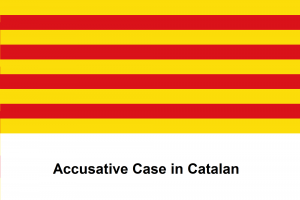Language/Catalan/Grammar/Accusative-Case-in-Catalan
In Catalan, the accusative case is used to indicate the direct object of a sentence. The direct object is the noun or pronoun that receives the action of the verb directly. In this lesson, we will learn about the accusative case in Catalan and how to use it correctly.
Consider broadening your understanding by checking out these related lessons: How to say "there is" in Catalan, Indefinite Articles in Catalan, How to use the Modal Verb Must in Catalan & Personal Pronouns.
Formation of the Accusative Case[edit | edit source]
The accusative case is formed by changing the form of the noun or pronoun that represents the direct object. Most Catalan nouns have the same form in both the nominative and accusative cases. However, masculine singular nouns that end in a consonant add "-u" in the accusative case. Feminine singular nouns do not change.
For example, "veure" means "to see" in Catalan, and to say "I see the car" in the accusative case, we would say:
"Jo veig el cotxe." ("I see the car.")
In this sentence, "el cotxe" represents the direct object in the accusative case. The noun "cotxe" is masculine singular, and it changes to "cotxu" in the accusative case.
Usage of the Accusative Case[edit | edit source]
The accusative case is used in several contexts in Catalan, including:
Direct Object of a Verb[edit | edit source]
The accusative case is used to indicate the direct object of a verb, as we saw in the example above.
Personal Pronouns[edit | edit source]
Personal pronouns in Catalan also have an accusative case. Here are the accusative forms of the personal pronouns:
- Em (me)
- Et (you, informal)
- El, la (him, her, it)
- Ens (us)
- Us (you, formal)
- Els, elles (them)
For example:[edit | edit source]
"Ells em veuen." ("They see me.")
In this sentence, "em" is the accusative form of the pronoun "jo" (I).
Prepositions[edit | edit source]
Some prepositions in Catalan require the use of the accusative case. For example:
- Per (for): Jo he comprat un regal per al meu germà. (I bought a present for my brother.)
- Amb (with): Ells van venir amb mi. (They came with me.)
Conclusion
The accusative case is an important part of Catalan grammar, and it is used to indicate the direct object of a sentence. By learning how to use the accusative case correctly, you can improve your Catalan language skills and communicate more effectively with native speakers.


